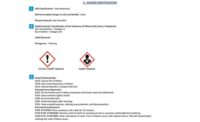Acquired from the supplier upon purchase of a chemical or substance, the MSDS is a fundamental document for setting into place a complete hazard communications program that is part of a larger health and safety workplace culture. The MSDS contains hazard evaluations on the use, storage, handling and emergency procedures related to that material. Employers must maintain a complete and accurate MSDS for each hazardous chemical that is used in their facility.
Specific information
OSHA specifies the information to be included on an MSDS, but does not prescribe the document's precise format, so formats might vary. The MSDS must be in English and must include at least the following information:
- Company information
- Hazardous ingredients
- Physical data
- Fire and explosion hazard data
- Health hazard data
- Reactivity data
- Spill or leak procedures
- Special protection information
- Special precautions.
When properly compiled by the supplier, the MSDS contains more information about the material than the container label. It is intended to tell what the hazards of the product are, how to use the product safely, what to expect if the recommendations are not followed, what to do if incidents occur, how to recognize symptoms of overexposure and what to do if such incidents occur.
When in doubt, ask
Traditionally, the intended readers of MSDSs were occupational hygienists and safety professionals. Now, other workers, supervisors, nurses, doctors, emergency personnel, and others routinely read these documents, so it's important to know how to interpret and to understand the information provided on MSDSs.Ask the proper personnel at your facility if you don't understand the hazards related to the chemical in question. If you can't make sense of an MSDS, consult Appendix II of the OSHA Hazard Communication Compliance Kit, which contains a glossary of terms used on MSDSs.
MSDSs are a comprehensive source of information for all types of workers, so some sections of the document may not be as useful to safety and health in your particular operation as others. Concentrate on the information that is applicable to your site, type of industry and specific situation, and always read the name of the chemical, know the hazards, understand safe handling and storage instructions, and know what to do in an emergency.
Easy access
Many companies have taken to putting their MSDSs online, thereby giving all their workers convenient access to the information. Regardless of where these documents are kept, online or otherwise, they must be easy to reach and readily available to workers.All hazardous substances must have an up-to-date (less than three years old) MSDS when it enters the workplace. The MSDS must be updated as new information about the chemical or substance becomes available. The chemical's manufacturers, importers or distributors must add the new information to the MSDSs within three months of the change and provide it to their customers with the next shipment of the chemical.
Whether to keep a very old MSDS or dispose of it often becomes an issue. It is usually wise to hang on to these documents, because sometimes a "harmless" chemical may be found to be hazardous in the future (asbestos is a good example). From a legal perspective, a corporation or business should be able to produce an MSDS for any chemical that has been used by its operations at any time.
Reading is fundamental
Workers should be familiar with the potential hazards and risks of a product before they start using it. Read the MSDS, matching the name of the chemical on the container to the one on the MSDS. Information on an MSDS aids in the selection of safe products and helps prepare employers and employees to respond effectively to daily exposure situations as well as to emergencies.SIDEBAR: No MSDS? Let OSHA know
If your supplier fails to send an MSDS with a shipment labeled as a hazardous chemical, you - the employer - must obtain one from the chemical manufacturer or distributor as soon as possible. Similarly, if the MSDS is incomplete or unclear, you should contact the manufacturer or importer to get the missing information.If you are unable to obtain an MSDS from a supplier or manufacturer, you can submit a written complaint to the nearest OSHA area office. OSHA will then follow-up on the complaint, contacting the supplier or manufacturer to obtain the needed information. If the supplier or manufacturer still fails to respond within a reasonable time, OSHA will inspect the supplier or manufacturer and take appropriate enforcement action.



